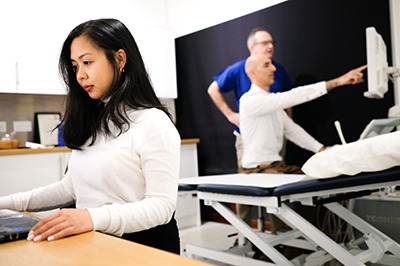What is an Ultrasound?
An ultrasound is a diagnostic medical test that uses high-frequency sound waves to produce images of organs and structures inside the body. It is used to examine a wide range of health conditions, from diagnosing pregnancy, to identifying tumours, to checking the heart and other organs. Ultrasounds offer a safe, non-invasive way to obtain images of your body's inner workings.
In this article, we will cover the basics of ultrasounds, what you can expect during the procedure and what kind of preparation you should do beforehand:
Types of Ultrasound
Ultrasounds come in several types and are used for many medical applications. The most common ultrasound is the abdominal ultrasound, which is used to evaluate organs in the abdomen including the liver, gallbladder, pancreas, and kidneys. Gastrointestinal ultrasounds are also used to diagnose and monitor diseases or conditions of the colon. Cardiac ultrasounds assist physicians in diagnosing heart problems while musculoskeletal ultrasounds may be used to assess muscle and joint problems.
A Doppler ultrasound provides information on blood flow through an organ or body part by employing sound waves that echo off circulating blood cells. These images can identify arterial stiffness, blockages in veins, a rapid heartbeat, or a heart murmur. Fetal ultrasounds can give expecting parents a glimpse of their developing baby in utero while breast ultrasounds are often used to assess lumps found during clinical exams of the breast tissue. Ultrasound-guided biopsies have become increasingly common as they offer guidance to collecting tissue samples from any area of the body for diagnostic testing or cancer screening purposes.
Benefits of Ultrasound
Ultrasound is a powerful tool for physicians in the diagnosis of many medical conditions, as well as for monitoring an unborn foetus's health during pregnancy. It provides a non-invasive, accurate and safe medical procedure to help detect diseases, assess foetal development and monitor the health of organs throughout the body. Below are some of the potential benefits an ultrasound can provide:
- Ultrasound helps to evaluate internal organs including the heart, kidneys, liver, pancreas and other abdominal structures as well as structures found in a woman’s uterus or breasts.
- Ultrasounds provide evidence of blood flow that cannot be seen with other imaging techniques such as X-rays or computed tomography (CT).
- Ultrasounds can detect signs of infection, determine if there are any blockages or abnormalities in internal organs, confirm the presence of cysts or malignant tumours and assess organ size and displays where irregularly shaped parts lie within them.
- When used during pregnancy ultrasounds are useful in detecting multiple pregnancies, evaluating fetal growth and helping to diagnose infants born with physical birth defects. They can also provide information about a baby's heartbeat and size of organs or structure that can help detection certain genetic disorders before birth such as Down Syndrome.
- Ultrasounds are also used commonly to guide doctors when performing invasive procedures, like placing a needle biopsy in internal tissues or joints including breast tissue biopsies or joint aspiration techniques using ultrasound guidance for accuracy and safety reasons during these procedures.
- For women who experience abdominal pain due to ovarian cysts they may be recommended an ultrasound to determine if any treatment needs to occur immediately or over time due to any changes found by the image performed by an ultrasound machine.
Preparing for Your Ultrasound
Preparing for your ultrasound can help you get the most out of the procedure. Knowing what to expect and how to get ready beforehand can make the process easier and more comfortable.
For instance, it is important to dress appropriately for your ultrasound and to make sure you are well-hydrated before the procedure. It is also important to make sure you have all the information you need about the procedure and the results.
Let's look at each of these topics in more detail:
Pre-Ultrasound Instructions
Before your ultrasound appointment it is important to follow the instructions provided to you by your doctor or medical staff. Be sure to carefully read any paperwork that you receive and ask questions if there is anything that you do not understand.
In most cases, an abdominal ultrasound will require some preparation which may include:
- Not eating or drinking prior to the exam in order to improve visualization of certain organs. You may need to fast for six to eight hours before the appointment time – be sure to check with your doctor for specific instructions.
- Avoiding smoking, chewing gum and wearing jewellery as these can interfere with image clarity.
- Informing your doctor if you are pregnant or have recently been pregnant – this information is necessary in order to avoid certain types of ultrasound waves which could harm an unborn foetus while they are still in utero.
- Reporting any allergies and current medications since some drugs can affect the accuracy of diagnostic images taken during an ultrasound exam.
- Wearing comfortable clothing which allows easy access for imaging areas such as the abdomen – wear a two piece outfit with a skirt or pants that can be pulled up easily in order for technicians to access relevant areas when preforming examinations.
What to Bring to Your Appointment
When getting prepared for your ultrasound appointment, it is important to bring all the necessary documents, items and information with you. The exact items you will want to bring may vary slightly from clinic to clinic and from situation to situation, but there are a few important things that you should always have with you when going in for your ultrasound.
Before attending your appointment, make sure that you have the following:
- Your ultrasound referral or order form provided by your doctor
- Your insurance card
- Any special forms or paperwork required by your clinic or insurance provider (this includes forms related to prior authorizations)
- A comfortable pair of trousers, skirt or shorts that can be rolled up above the area being examined
- A personal device such as an MP3 player or iPad if available (for distraction during exam)
- Any additional questions that may arise related to the procedure taking place
Depending on the type of examination being performed (and individual provider preferences), it is also recommended that you do not eat anything for several hours prior to keep a full bladder. It is also advised that patients avoid wearing any type of jewelry or accessories that might hinder the technician in completing their assessment as desired.
During the Ultrasound
During your ultrasound, your technician will use a transducer to send sound waves through your body and record the images for your doctor to review. It is important to remain as still as possible during the ultrasound to make sure the images are clear. Your technician may ask you to hold your breath for a few seconds during this process.
Depending on the type of ultrasound you are having, the technician may also apply gel to the area being examined. It is important to stay relaxed and follow the technician’s instructions throughout the ultrasound.
What to Expect During the Exam
An ultrasound exam is a non-invasive, painless procedure that uses harmless sound waves to create images of the inside of your body. It is usually performed by a specially trained healthcare professional called a sonographer.
Your doctor will order an ultrasound for diagnostic purposes, to monitor their progress with pregnancy, or to evaluate organs or other structures in the body.
The sonographer will explain what you can expect during the exam and will review any measures taken to prevent infection such as wearing protective clothing and gloves. They will also take safety precautions during the scan, such as avoiding placing the transducer directly on your skin or positioning it close to metal objects. The sonographer may apply a special type of gel such as ultrasound jelly on the area being examined in order to enhance the quality of images produced by the scanner.
You may be asked to change positions during the exam in order to obtain clearer pictures of certain areas and limit blurriness due to movement. The duration of an ultrasound depends on which parts of your body are being scanned, but typically takes no more than 30 minutes. You can expect some noise while images are taken; this noise should not cause you discomfort or distress and should subside when imaging ends.
Preparing for the Results
Getting ready for the results of your ultrasound is an important part of the process. It can be hard to make sense of the medical speak your doctor might use, so we’ve broken down what you need to know and how you can prepare for your appointment.
The final section of the ultrasound assessment will be preparation for results. The technician will explain that you should wait until you meet with your doctor to discuss the results of the test before making assumptions about anything. Your technician should also advise that it could take a few days or even several weeks for your doctor to get back to you, depending on the complexity of your case. You may even want to book a follow up appointment so that a more detailed review and conversation can be had in person with your doctor.
Understanding Ultrasound Results: Knowing what typical ultrasound results look like helps tremendously when trying to interpret results alongside a knowledgeable medical professional. Images will describe size, shape, location and anatomy, such as solidity or mass, as well as differences in acoustic density and colour; these are often discussed by medical professionals in terms like heterogeneous or hypoechoic (lower reflected sound), hyperechoic (higher reflected sound) or anechoic (non-reflection). Make sure to ask any questions you might have so that when looking at images with your doctor they are clearly understandable – this could relate to morphological changes or diagnosis information.
After the Ultrasound
After your ultrasound, your doctor or ultrasound technician will provide you with the results of your exam. Depending on the type of ultrasound you had, they may explain the results to you in detail or provide a written report. If there are any follow-up appointments that need to be scheduled, your doctor will tell you what to expect and what to do.
In this section, we will discuss what you should do after your ultrasound:
Understanding the Results
Your medical professional will try to explain and interpret the results of your ultrasound in terms you can understand. It helps to ask questions if you're unsure what they mean. Your medical professional may be able to provide some additional guidance regarding any concerns you have regarding the findings of the ultrasound, but they will usually refer you to a specialist who can explain more thoroughly and offer more targeted advice.
In most cases, the results of an ultrasound will be given as soon as possible. However, for certain procedures – such as abdominal ultrasounds – there may be an additional wait time for further tests or to get the particulars from a radiologist or other specialist before providing an accurate interpretation.
It is important to remember that ultrasounds are a tool for diagnosis and your doctor or technician will typically combine them with other tests and observations when making decisions about treatment or follow-up care. Depending on the reasoning behind why you had an ultrasound, your doctor may recommend further tests and procedures once he or she has reviewed all the data from your procedure.
When understanding the results from an ultrasound, it's also important to read any included information sheets carefully before scheduling any additional appointments or engaging in treatments. These sheets should provide you with helpful answers about what these results mean along with advice on how best to take action based on them.
Follow-up Care
Once the ultrasound is complete, your doctor will evaluate the images and provide a report of their findings. The doctor may need to contact you to discuss the results, or arrange additional tests or medical care. Following up with your healthcare provider is important and it’s important to schedule appointments promptly if further tests are required.
Depending on the procedure, you may need to take special precautions such as avoiding certain activities or heavy lifting for a period of time as instructed by your doctor. It’s important that you follow all post-procedure instructions closely in order to maximize the accuracy of the results and ensure full recovery.
If you experience any signs of medical distress such as chest pain, shortness of breath, dizziness or confusion during follow-up care, contact your doctor immediately.
Risks and Complications
Ultrasound imaging is generally considered to be a safe procedure, but as with any medical procedure there are some risks and potential complications. In order to understand the risks associated with an ultrasound, it's important to know how the procedure works and the possible side effects it can cause.
Keep reading to learn more about the risks and potential complications of having an ultrasound:
Potential Risks
It is important to understand the potential risks and complications associated with any medical procedure. While ultrasound is generally considered to be safe, there are some potential risks.
Ultrasound carries no known risks or side effects, as children in utero do not appear to be affected in any way by the sound waves used during ultrasound. With that being said, some pregnant women report experiencing slight discomfort due to the technician pushing down on their abdomen during the procedure, a feeling akin to mild cramping.
More rare but still possible complications include:
- Tissue heating (due to incorrect length of ultrasound pulses)
- Shocks from unshielded cables that conduct electricity
- Acoustic streaming (the formation of bubbles due to high intensity ultrasound beams)
- Another risk involves fabricating false positive findings due to inadequacies in technique or inadequate training of the operator.
Ultimately, it is always best for a woman ahead of time if steps can be taken before the procedure is performed in order to reduce any potential risks associated with an ultrasound. Pregnant women should consult their health care provider and technician prior to having an ultrasound performed in order ensure that all necessary measures are taken into account for a safe and successful experience.
Common Complications
Ultrasound scans are generally very safe and do not involve any radiation; instead, they use sound waves to create an image of your baby. There are, however, some risks associated with ultrasound scans that you should discuss with your healthcare provider before undergoing the procedure.
Common complications associated with ultrasound scans include:
- False positives or false negatives: a false positive result occurs when a scan suggests a problem exists even though there is none; and a false negative result occurs when a scan does not detect an abnormality even though one exists.
- Inaccurate results: Ultrasound images are only estimates of a baby’s size and position. A more accurate picture can usually be obtained from an amniocentesis test or another diagnostic procedure.
- Heating effect: Strong sound waves may cause small pockets of heat in the body during an ultrasound scan; however, these pockets dissipate quickly and cause no lasting damage or harm to the baby or mother.
- Harm to mother/fetus: Rarely, if the procedure is performed incorrectly and/or taken too far there may be potential harm to the mother or developing baby such as tissue burns, mental retardation and even loss of pregnancy due to extreme trauma caused by repeated ultrasounds at high intensity frequencies.



